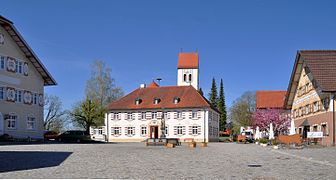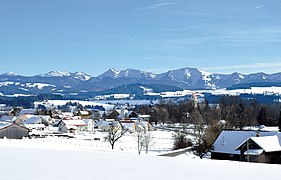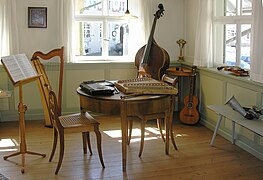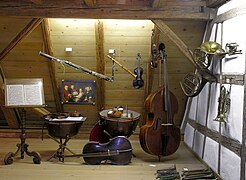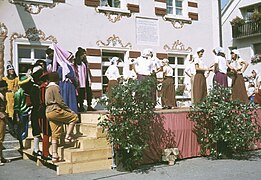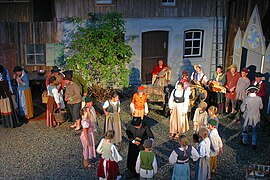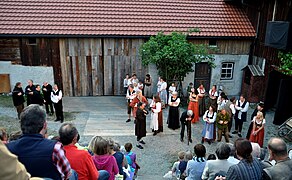Eglofs (Argenbühl)
|
Eglofs
Argenbühl municipality
|
||
|---|---|---|
| Coordinates: 47 ° 39 ′ 45 " N , 9 ° 55 ′ 56" E | ||
| Height : | 662 m above sea level NN | |
| Area : | 23.4 km² | |
| Residents : | 1645 (Jan. 1, 2016) | |
| Population density : | 70 inhabitants / km² | |
| Incorporation : | January 1, 1972 | |
| Postal code : | 88260 | |
| Area code : | 07566 | |
|
Location of Eglofs in Baden-Württemberg |
||
In terms of size and population, Eglofs is the largest village in the municipality of Argenbühl in the Ravensburg district in West Allgäu, which was created in 1972 through the amalgamation of several municipalities . The state border with Bavaria runs on the southern edge of the village .
Geography and transport links
The village is on the B 12 , which connects Wangen im Allgäu with Isny im Allgäu and thus on the route of the Upper Swabian Baroque Road . The 761 meter high "Isnyberg" is the highest point in the Argenbühl area.
Local division
Eglofs includes the hamlets of Aschen, Bruckacker, Bühl, Burg, Eyb, Gaischachen, Gerazreute, Gießen, Goldbach, Heuberg, Hochberg, Hofs, Hummelberg, Isnyberg, Laidraz, Linzgis, Lochhammer, Malaichen, Moos, Mühlbolz, Mühlhalden, Oberisnyberg, Obervorholz , Osterwaldreute, Reute, Schaulings, Schnaidt, Schönenberg, Staudach, Steinberg, Straß, Tal (Eglofstal), Untervorholz, Waibelhof and Zellers, the farms Bellmannshöfle, Biegen, Birkhardt, Buchenberg, Dampfhof, Edenhaus, Fuchshof, Greut, Gründels, Halden, Hinterberg, Hintergreut, Huttershöfle, Kaltenherberg, Kolbenberg, Lochershöfle, Schnaidthöfle, Schwinders, Stall, Untergoldbach and Zimmermannshof and the houses Locherkapf and Bühl schoolhouse.
history
During the Middle Ages, the residents of Eglof were largely free farmers and, since they had had town charter since 1282, they were also citizens in the medieval legal sense . They were able to retain their special rights into the early modern period, with certain losses.
A prehistoric settlement has not yet been proven. The earliest settlement phase is also in the dark. The fact that the Martinspatrozinium could indicate a settlement by Franconian or people close to the Franks in the later Carolingian period is questioned, as is the assumption that Eglofs was settled with Leutkirch , whose parish church was also consecrated to the patron saint of the Franks, Saint Martin is. At the end of the Early Middle Ages and the beginning of the High Middle Ages, the area belonged to the Nibelgau , the count's rights of which were last exercised by the Counts of Bregenz . Parts of it then formed the county of Eglofs. It was subordinate to the Counts of Kirchberg , and then the Counts of Württemberg, who later called themselves Counts of Grüningen .
In 1243 Hartmann I von Grüningen sold the county of Eglofs to Emperor Friedrich II. The purchase price was 3200 marks silver - an extraordinarily high sum according to scientific estimates - of which the Eglofs themselves contributed 1000 marks in several installments. So you must have been wealthy, if not rich, farmers by that time to make such a financial commitment. Eglofs is thus directly imperial , that is, it was directly subordinate to the king or emperor, the fideles (= faithful) enjoyed his protection and were only obliged to pay taxes and services to him. In 1271 Eglofs was mentioned in the Liber decimationis with 71 farms, in 1353 in the tax book of the Constance diocese, probably only at 60 due to the plague years. King Rudolf I confirmed the privileges already granted by Friedrich in 1282 and granted the Eglofsern the town charter of Lindau . With certain restrictions, Eglofs became a town from a legal point of view, chose an independent administration, had full jurisdiction (i.e. only restricted by imperial law) and extensive tax sovereignty. Its citizens owned the Free Train , which meant that they could settle in other cities as free citizens or, as expatriates, enter the legal sovereignty of a city. Associated with this confirmation of the privileges and the granting of city rights was a waiver of pledge. However, the notorious lack of money of the German emperors led to permanent pledges to different noble families, among which the Schellenberger , Werdenberg - Heiligenberger and various lines of the Montforter were pledges for longer periods of time. Since the pledgee could only make a profit from their investment by increasing their duties and obligations, the economic position of the Eglofs was gradually weakened. First and foremost, this affected the free people, some of whom lived a considerable distance from the Eglofs district but enjoyed Eglofs privileges, grouped into the two tax districts of Unterer Sturz (around Missen ) and Oberer Sturz (left of the Iller from Oberstdorf to the northern Alpsee area) , while the citizens of Eglofs were able to maintain their privileges, in part also by buying back liens or speaking directly to the Reichstag. The free in the falls, on the other hand, sank towards the end of the Middle Ages into a form of serfdom, softened by certain rights of freedom, and had to recognize the jurisdiction of the respective rule.
In 1516, the city of Wangen, as a pledgee of Eglofs, further restricted the rights of the “Free of Eglofs” and at the same time increased the taxes, although these were still rather low compared to the taxes and service burden of other farming societies in the Westallgäu. In 1522, the Wangen hospital also received patronage over the parish church. These rights losses and tax increases probably led to Eglof's participation in the Peasants' War of 1525. In May 1525, parts of the Allgäu heap were encamped in Eglofs, plundered and pillaged the bailiwick and the rectory, but soon moved to Kißlegg . Overall, however, the Eglofs 'participation in the Peasants' War of 1525 was apparently more due to their lengthy legal dispute with the pawnbroker Wangen than to an identification with the ideas of the peasant uprising. There also seem to have been no serious consequences for the Eglofser after the defeat of the farmers.
The "Free of Eglofs" were able to maintain their special position as an imperial village until after the Thirty Years' War , which had a particularly devastating effect in southern Germany through the years of marauding, especially the Swedish Soldateska, as well as the subsequent plague . Due to the aftermath of the long war, the social, legal and economic position of the Eglofs peasant citizens deteriorated after the acquisition of the imperial rule of Eglof in 1662 by the Counts of Abensperg and Traun . Although they were able to receive most of their personal freedom and property rights, their position as an imperial-free community was lost forever. After another sale in 1804 to the Princess von Windisch-Graetz and an interlude as the Principality of Windisch-Graetz , the area around Eglofs fell to the Kingdom of Württemberg in 1806 according to the Rhine Confederation Act .
In one of the last witch trials in 1743, Katharina Reitterin was the victim of the witch hunts and burned in Eglofs.
With the mediatization of 1806, the princes of Windisch-Grätz lost sovereignty, rule and property rights. They received the latter for the first time in 1811, and after they had been withdrawn again in 1817, finally in 1828. The reason for the withdrawal was unclear loyalty relationships, since the princes of Windisch-Grätz were in the service of the Austrian Empire . Politically, in the border treaty between Bavaria and Württemberg in 1810, the affiliation of Eglofs to Württemberg was confirmed and Eglofs part of the Danube District , namely its southernmost administrative district, the Oberamt Wangen . The areas in the falls, which were counted as part of Württemberg immediately after the mediatization, came to Bavaria.
Particularly stressful for the Eglofs was the increasingly restrictive authorization to use the forest freely, which led to lengthy processes with the rulers in which they claimed their legal rights. Finally, in 1832, a favorable comparison was reached in which the approximately 250 hectare Osterwald remained at the sole disposal of the Eglofsers, but the Westerwald came under the exclusive right of use. This led to the founding of the wood utilization cooperative that still exists today, the Osterwaldgenossenschaft Eglofs.
Eglofs had 1,349 inhabitants in 1841 and was the third largest municipality in the Oberamt after Sommersried and Pfärrich . The majority of the residents owned their farms and houses, and the taxes were low. Nevertheless, the prosperity was rather moderate and there were many poor . In addition to the Prince of Windisch-Grätz, Count Quadt zu Wykradt and Isny and the Hospital of the Holy Spirit in Wangen, tenth takers.
On January 1, 1972, Eglofs formed the new municipality of Argenbühl together with five other municipalities.
Buildings
Parish Church of St. Martin
The former church, which was described as dilapidated in 1485, was rebuilt in the Baroque style by Johann Georg Specht from 1765 to 1766. Only the bell tower (late 14th century) with the Theresienkapelle and the simple exterior remind of the Gothic building . Upon entering, the light-flooded, uniform interior with its rococo decorations surprises . The remarkable stucco work was renewed in 1931.
The high altar shows the Assumption of Mary into heaven on the large altar panel by Franz Anton Weiß . The free-standing popular altar with the ambo dates from 1973 . A work by Anton Stiefenhofer from Eglofs (around 1790) is the Madonna with a child in her arms. The side altars go back to Eglofs brotherhoods , which arose after the plague during the Thirty Years' War.
On the ceiling in the choir is the picture of the Last Supper in the middle between the four church fathers , again by Franz Anton Weiß. The large fresco by Joseph Jacob Spieler in the nave shows the fighting, suffering and triumphant church with saints and apostles on the ceiling. The expulsion of the merchants from the temple above the gallery was not completed until 1931 , based on designs by the church painter August Braun from Wangen .
Secular buildings
The village square in the center of the village is a wide, slightly inclined, representative square with a neo-Gothic fountain. The square is surrounded by some respectable buildings, the former bailiff's office and later town hall, the Gasthaus zur Rose , the Gasthaus zum Löwen and the museum.
Megelolf Castle - a disused complex that can no longer be located today.
Culture
societies
The oldest association is the church choir , which according to sources in the parish archives has existed for over 200 years. The Eglofs band has been making music since 1842 . The Liederkranz Eglofs , today the Eglofs men's choir , was created in 1988 from the fire brigade (mentioned as early as 1810), to which a yodel club had to join in 1933 . The veterans 'association made up of participants in the Franco-German War in 1871 was founded in 1873 and still exists today as the Eglofs' warrior and reservist comradeship . It commemorates the dead of the wars annually on the Warrior's Day . The cycling club "All Heil" existed from the beginning of the 20th century until 1969 and became the local and traditional costume club "D'Syrgensteiner" with a group of mountain traditional costume .
Gießen also had a cycling club from 1921, which eventually became part of the Gießen rifle club . As early as 1749, a “shooting range” was shown in a picture in Eglofstal. The Eglofs Rifle Guild was founded as an association . In 1951 the sports club Eglofs started with gymnastics, athletics, swimming and skiing. A women's handball team became Wuerttemberg runner-up in 1965. The skiers shone at the Württemberg and German championships. Cross-country skiers took part in world championships and a senior world champion can be reported at Alpin. A motorsport club was founded in 1982.
The history and homeland association goes back to 1982. To show the history in theater plays, to archive local and regional music culture and to show it in the museum are among the goals of the association. The Osterwald cooperative has existed since 1832 after a 20-year battle for the use of the Osterwald.
The Dorfstadelförderverein takes care of the culture of the versatile hall with stage, the "Dorfstadel", next to the museum on the village square, while the new club and citizen service takes care of the use of the old Eglofs town hall. The ChorKontraste choir has existed since 1989 with participants from Eglofs and the surrounding area with a very demanding repertoire. Next: Senior citizens' community Eglofs, CDU local association Eglofs, Grüß-Gott-Verein, hunting cooperative Eglofs, chapel community Bühl, Catholic rural youth movement, rural women Eglofs and local agricultural association.
Regular events
On January 6, attract acolytes as Epiphany from house to house. Most traditionally, the fire brigade ball is usually on "Bromigen Friday", alongside other carnival balls organized by the clubs. Since 1985 there has been the “Children's Carnival” on Carnival Sunday with an event in the gym. The radio Sunday a week later closes the crazy days of burning witches on hills around.
The court day has been held in the Dorfstadel since 2001, on which “major offenses heanat and deanat are punished”, based on the historical Ash Wednesday court days of the Eglofser Free. On the “Musical Afternoon”, young musicians not only from the local and traditional costume association offer a colorful afternoon in the village hall. The first communion is an important event in Catholic life that always accompanied the band Eglofs. Two shooting clubs regularly invite everyone to shoot. At the beginning of May the band will play for the Mother's Day concert in the gymnasium and festival hall. In 2008 the procession took place through the corridors around Eglofs. Since 2009 the believers of Argenbühl have been meeting on a star march on the Siggener Höhe. In June, Corpus Christi is a big festival. In July, the five Argenbühl brass bands meet on the village square for a star march and then make music together. At the rural youth village festival on the village square, people collect for a good cause. The chapel festival in Bühl helps to preserve the chapel.
Since 1988 a market has been held on the village square on the last Saturday in August every year, offering handicrafts from pottery to wood and leather work, blacksmithing, paintings and jewelry. In memory of St. Martin , the church saint , the Eglofs associations meet at the patronage in November.
On the 1st of Advent, traditional ways and songs for the Alpine Advent sound in the Dorfstadel. The “Kloose” will also move through Eglofs on December 5th. Church concerts by winds and singers for Advent alternate every year. The New Year's Eve blowing in small music groups from house to house ends the year. The largest balloonist meeting in southern Germany took place under the name "Eglofser Feuerzauber" from 2003 to 2014 every year in Eglofs.
museum
Since 2002, the restored old farmhouse has been showing a music museum set up by the History and Local History Association, which offers an overview of regional music history in the West Allgäu on the basis of a music archive with collections of images, sounds, books and music in a total of over 50,000 PC entries. In addition to the bagpipes and hurdy-gurdy , string, plucked and wind instruments with their historical development, church music, choral tradition, brass music and musical personalities form the thematic focus. Unusual instruments such as trumscheit , chalumeau , flap horn , violin zither , straw violin and also a Tefifon can be seen. Fossils and minerals, stove tiles and panels on Eglofs history are also housed here.
There are sound samples that can be called up, individual audio guides and, in a multimedia show, the own Eglofs story with the plays listed so far. In 2009, the Tübingen Regional Council awarded the museum the title “Exemplary Local Museum”.
theatre
In the first year of the Eglofs history and homeland association, the special story of Eglofs was brought to the stage in self-written plays with actors from the local area. In 1982 it was about obtaining imperial immediacy and city rights . The main content in ten different pieces from the period since 1282 remained the arguments with the later pawnbrokers until the long trial over the Osterwald. From the beginning of the 20th century it was the stories about the "Schuhmichel", an Eglofs shoemaker's original, that were performed twice. The most successful play so far was "Katharina", who was burned as an alleged witch 34 times in the village square. With the piece “Schatten der Nacht” (2015), they ventured into the future, in which the Eglofs also managed to regain their freedoms in the surveillance age of the cyber world.
Economy and Infrastructure
Agriculture
The former mixed agriculture with flax cultivation developed in the 19th century into grassland farming with the production of milk and cheese. Smaller dairies in Aschen, Eglofstal and Eglofs were merged in 1960 to form the central dairy cooperative Eglofs. Up to 1986, up to 30 wheels of Emmentaler were produced daily in new production facilities . The few farms now supply other large-scale processing companies with “ hay milk ” or milk from silage . Maria Schele in Schnaidt opened a farm cheese kitchen with different types of cheese.
Business
Three distilleries deliver schnapps made from pome and stone fruit. The Schäferhof Greber in Maleichen offers meat and its own wool products from its own sheep breeding. The former Kleiner Bakery continues to sell baked goods and groceries today.
The Fersen motor vehicle company works in the former dairy building. In Eglofstal, Schele (sawmill) also supplies its own electricity for processing worktops. Massage tables are manufactured by a metal processing company. There are also: a surveying office, two construction companies, two carpentry shops, two companies for house and energy technology, a painting shop and a fashion studio A. Bischofberger. PROAIR in Reute is an international manufacturer of DELPHIN cleaning devices and also supplies photovoltaic systems with SOLAR. Three gardeners and landscapers are registered.
In the new industrial area in Eglofstal, in addition to gardening and landscaping Präger, the Klaus joinery, the tile specialist Musch and the company HM-Bauleistungsservice.
tourism
Since the 1960s, the family recreation center of the Diocese of Rottenburg has been offering holiday homes and apartments for families, groups and school camp stays, each with special care. The former hotel "Bromerhof" is a clinic as a mother / father-child facility for prevention and rehabilitation. Private holiday apartments are also offered. A natural outdoor pool, the "mud bath", is there for bathers in summer, the "panorama bath" with sauna at the school center in the cold months. In the show garden, the "herb garden" Tschöll, in Zellers, a world of flowers and herbs can be viewed.
The Allgäu hiking trilogy , the Allgäu cycle tour , the Oberschwaben-Allgäu-Weg cycle path , the Lake Constance-Königssee cycle path and the Upper Swabian Baroque Road lead through Eglofs .
gastronomy
In addition to the two inns on the village square, "Rose" and "Löwen", the "Bären" in Eglofstal on the main road has more guests from through traffic. The café and Cramerlädle are also in the center of the village. The beer garden and barbecue area "Ochs am Berg" is located in the hamlet of Untervorholz near the main road.
education
In addition to a kindergarten , Eglofs had a primary and secondary school , the former elementary school , to which the one-class school in Bühl came in 1968 . In 1978 the new secondary school was built on the outskirts by the sports facility with a gym and teaching pool , which had to be enlarged in 1996. In 2010, together with the secondary school from Ratzenried, the Werkrealschule Eglofs / Ratzenried was established and in 2012 the community school -Argenbühl in Eglofs. In 2016 an extension was added. Since 2013, the elementary school and the elementary school from Eisenharz have formed a joint rectorate Eglofs-Eisenharz.
coat of arms
The coat of arms is derived from the seal of the "Free of Eglofs" documented from 1474 to 1665. It shows the one-headed imperial eagle with a linden branch in its beak. The linden branch refers to the linden tree in the Lindau coat of arms.
Nature reserve
Within the district Eglofs about one kilometer east of the village center is a small, 20.0 ha large nature reserve (NSG no. 4216) Staudacher pond resulting from the water surface of the pond, the reeds and silting zone and small scrubby and forested border areas consists. It is a habitat worthy of protection for the typical flora and fauna of border alpine wetlands and also resting area for birds passing through.
Awards
- Most beautiful village in Baden-Württemberg , gold medal 1998
literature
- Peter Blickle: The Eglofser Free . Printing of the lecture from September 4, 1982. Municipality of Argenbühl 1982.
- Trude Bethge: the free people belonging to the megloffs . History and Heimatverein Eglofs eV 1993.
- Peter Blickle: The Free Republic of Eglofs . Printing of the lecture from September 18, 1993. Municipality of Argenbühl 1994.
- Otto Beck: The parish church of St. Martin in Eglofs in the Allgäu . Fink, Lindenberg 2004, ISBN 3-89870-198-0 .
- Catherine De Kegel-Schorer: The free ones on Leutkircher Heide . Origin, shape and erosion of an Upper German farmers' cooperative. libraryca academica Verlag Epfendorf 2007. ISBN 978-3-928471-50-3 .
- Peter Kissling: The Eglofser Free . In: Peter Blickle (ed.): Hidden republican traditions in Upper Swabia. bibibliotheca academica Verlag Tübingen 1998. ISBN 3-928471-22-8 .
- Peter Kissling: Free farmers and rural citizens . Eglofs in the late Middle Ages and in the early modern period. library academica Verlag Epfendorf 2006. ISBN 3-928471-53-8 .
- Oskar Sailer (ed.): The district of Ravensburg . Theiss, Stuttgart 1976, ISBN 3-8062-0145-5 .
- Wolfram Benz: Eglofs . History and local history association Eglofs eV 2010.
- Wolfram Benz: Eglofs used to be . History and Heimatverein Eglofs eV 2012.
Individual evidence
- ↑ Erhard Nietzschmann: The free in the country. Former German imperial villages and their coats of arms. Melchior, Wolfenbüttel 2013, ISBN 978-3-944289-16-8 , p. 27.
- ^ Kissling (2006) p. 421
- ↑ Catherine De Kegel-Schorer (2007) pp. 32–35
- ^ Gerhard Köbler : Historical Lexicon of the German Lands. The German territories from the Middle Ages to the present. Beck'sche Verlagsbuchhandlung Munich 1999. ISBN 3-406-44333-8 . P. 145
- ↑ Kissling (2006) p. 33 (note)
- ↑ Author's note: about 233 kg of silver - an ox cost about 4 marks, so just under 1 kg
- ^ Alfred Weitnauer: Allgäuer Chronik vol. 1 Kempten 1969 p. 206
- ↑ Peter Kissling (1998) p. 166
- ^ Kissling (2006) p. 147
- ↑ The gruesome story of a seriously ill woman. Lecture about Katharina Reitterin
- ↑ Description of the Oberamt Wangen 1841
- ^ Border treaty between Bavaria and Württemberg - Art. 1
- ↑ Description of the Oberamt Wangen 1841
- ^ History of the Osterwaldgenossenschaft
- ↑ Description of the Oberamt Wangen 1841
- ^ Federal Statistical Office (ed.): Historical municipality directory for the Federal Republic of Germany. Name, border and key number changes in municipalities, counties and administrative districts from May 27, 1970 to December 31, 1982 . W. Kohlhammer, Stuttgart / Mainz 1983, ISBN 3-17-003263-1 , p. 536 .
- ↑ Otto Beck: The parish church of St. Martin in Eglofs in the Allgäu . Kunstverlag Josef Fink, Lindenberg. ISBN 3-89870-198-0
- ^ Georg Dehio: Handbook of German Art Monuments. Baden Württemberg. Arranged by Friedrich Piel. Deutscher Kunstverlag 1964. p. 98
- ↑ The Eglofs Church Choir
- ^ Eglofs music band
- ↑ Men's choir Eglofs ( Memento of the original from January 3, 2017 in the Internet Archive ) Info: The archive link was inserted automatically and has not yet been checked. Please check the original and archive link according to the instructions and then remove this notice.
- ^ The warrior and reservist comradeship
- ↑ Heimat- und Trachtenverein
- ↑ Giessen shooting club
- ↑ MSC Eglofstal
- ↑ Eglofs History and Local History Association
- ↑ Benz (2012) p. 73 ff.
- ^ History of the Osterwaldgenossenschaft
- ↑ Association and Citizen Service
- ↑ Choir Contrasts
- ↑ Bühl Chapel Community
- ↑ Benz (2010) p. 65 ff.
- ^ Theater in Eglofs
- ↑ Hofkäseküche Maria Schele
- ↑ Greber Shepherd Farm
- ↑ Automotive heels
- ↑ Schele worktops
- ↑ Construction company Deiss ( Memento of the original from October 2, 2016 in the Internet Archive ) Info: The archive link was inserted automatically and has not yet been checked. Please check the original and archive link according to the instructions and then remove this notice.
- ↑ Construction company Rast ( Memento of the original from January 5, 2017 in the Internet Archive ) Info: The archive link was inserted automatically and has not yet been checked. Please check the original and archive link according to the instructions and then remove this notice.
- ↑ Carpentry Rast ( Memento of the original from August 28, 2018 in the Internet Archive ) Info: The archive link was automatically inserted and not yet checked. Please check the original and archive link according to the instructions and then remove this notice.
- ↑ Kränzle carpentry
- ^ Home and energy technology De Martin
- ↑ Home and energy technology Hein
- ↑ Morent painter
- ↑ PROAIR GmbH
- ↑ Grünerleben Andrea Schmid ( Memento of the original from July 30, 2016 in the Internet Archive ) Info: The archive link was inserted automatically and has not yet been checked. Please check the original and archive link according to the instructions and then remove this notice.
- ^ Karl Milz gardening and landscaping
- ^ Horticulture Präger
- ↑ Klaus Carpenter
- ↑ Musch tiles
- ↑ HM Construction Service
- ↑ Family Recreation Agency
- ↑ Bromerhof Specialist Clinic
- ↑ Eglofs Guest Association ( Memento of the original from May 23, 2014 in the Internet Archive ) Info: The archive link has been inserted automatically and has not yet been checked. Please check the original and archive link according to the instructions and then remove this notice.
- ↑ The natural outdoor pool, "Mud Bath"
- ↑ Panoramabad Eglofs
- ↑ Tschöll Herb Garden
- ↑ Hotel and Gasthaus zur "Rose"
- ↑ Hofwirtschaft Ellgass
- ↑ Dorfcafé and Cramerlädle
- ↑ Beer garden and barbecue area "Ochs am Berg"
- ↑ Community School Argenbühl-Eglofs ( Memento of the original from January 20, 2017 in the Internet Archive ) Info: The archive link was inserted automatically and has not yet been checked. Please check the original and archive link according to the instructions and then remove this notice.








